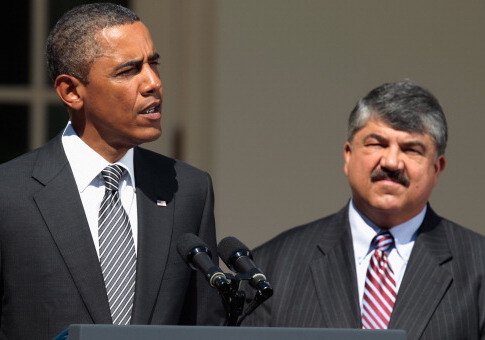President Obama's rules speeding up the union election process increased the chances of union victory, according to a new analysis.
Union victories in secret ballot elections have held steady since the Democrat-controlled National Labor Relations Board amended its election rules to fast-track union votes and increase the personal information companies must give to labor organizers. The shortened window between filing for an election and holding one, however, may be propping up union success, according to an analysis from management-side law firm Fisher Phillips. When the NLRB, which oversees union elections, schedule elections within a two-week period, unions emerge victorious nearly 83 percent of the time. Their success rate plummets if employees are given more time to weigh the potential benefits and costs of exclusive union representation.
"When elections happen in 14 days or less, unions win at higher rates, 82.4 percent compared to 66.6 percent," the analysis found. "Meanwhile, management win rates have remained virtually unchanged from 32.9 percent in 2014-2015 to 33.2 percent in 2017-2018."
Unions typically have an advantage in elections because they are unlikely to petition if they do not think they can prevail. Labor groups won 69 percent of union elections in 2017, on par with historic rates, though it ticked up from unions' 64 percent win rate in 2013, the year before new rules were adopted, according to the NLRB. Union gains have increased sharply for small businesses which may not have labor attorneys on-hand to guide them through the process, according to Fisher Phillips' Steve Bernstein.
"Before the rule was changed, the union-win rate for bargaining units with 25 or less people was 69 percent. In the three years since, the win rate went up to 74 percent," he said.
Management-side attorneys and employers have protested the Obama administration election rules, which went into effect after the president vetoed a congressional resolution intended to block the sped-up timeframe. Unions can spend years organizing secret-ballot elections, but employers can run afoul of labor law for making the case against unionization outside of the formal election period. Elections now move at a faster pace. NLRB data show voting begins an average of 23 days after a petition, a 40 percent reduction from the 38 days it took before the rules were adopted. Bernstein said the effects are most pronounced in small businesses where employers may not have time to train supervisors and middle management to comply with labor law, as well as the confusion concerning which employees are able to vote in the election. The win-rate nationwide may be the same, but the new rules have given labor organizers a larger window to dispute results and overturn losses.
"That's not something that's going to show up in election results [statistics], but can show up in unfair labor practice complaints," Bernstein said. "It's very tough for an employer to deal with these issues in real time.… It's been a recipe for confusion."
The NLRB is currently reviewing nearly 7,000 public comments submitted by union advocates, employers, and labor law experts on both sides to revisit the rule. The timetable on any revision is flexible—the agency extended the comment deadline from March to April previously—as officials and board members weigh the issue.
